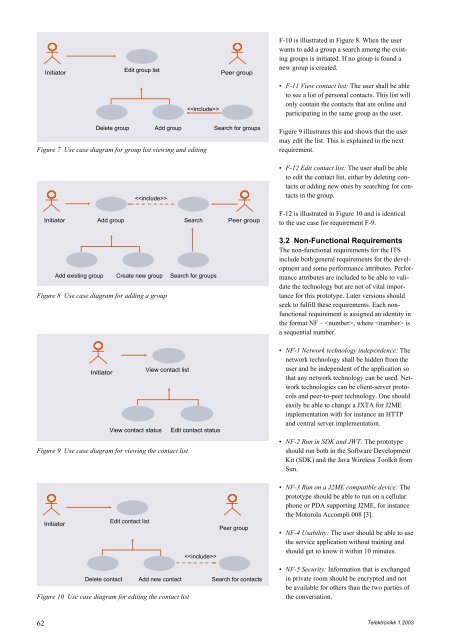Intelligent Transport Systems - Telenor
Intelligent Transport Systems - Telenor
Intelligent Transport Systems - Telenor
Create successful ePaper yourself
Turn your PDF publications into a flip-book with our unique Google optimized e-Paper software.
62<br />
Initiator<br />
Edit group list<br />
Peer group<br />
Figure 7 Use case diagram for group list viewing and editing<br />
Figure 8 Use case diagram for adding a group<br />
Figure 9 Use case diagram for viewing the contact list<br />
Figure 10 Use case diagram for editing the contact list<br />
<br />
Delete group Add group Search for groups<br />
Initiator Add group<br />
Search Peer group<br />
Initiator<br />
Add existing group Create new group Search for groups<br />
Initiator<br />
<br />
View contact status Edit contact status<br />
Edit contact list<br />
View contact list<br />
Delete contact Add new contact<br />
<br />
Peer group<br />
Search for contacts<br />
F-10 is illustrated in Figure 8. When the user<br />
wants to add a group a search among the existing<br />
groups is initiated. If no group is found a<br />
new group is created.<br />
• F-11 View contact list: The user shall be able<br />
to see a list of personal contacts. This list will<br />
only contain the contacts that are online and<br />
participating in the same group as the user.<br />
Figure 9 illustrates this and shows that the user<br />
may edit the list. This is explained in the next<br />
requirement.<br />
• F-12 Edit contact list: The user shall be able<br />
to edit the contact list, either by deleting contacts<br />
or adding new ones by searching for contacts<br />
in the group.<br />
F-12 is illustrated in Figure 10 and is identical<br />
to the use case for requirement F-9.<br />
3.2 Non-Functional Requirements<br />
The non-functional requirements for the ITS<br />
include both general requirements for the development<br />
and some performance attributes. Performance<br />
attributes are included to be able to validate<br />
the technology but are not of vital importance<br />
for this prototype. Later versions should<br />
seek to fulfill these requirements. Each nonfunctional<br />
requirement is assigned an identity in<br />
the format NF – , where is<br />
a sequential number.<br />
• NF-1 Network technology independence: The<br />
network technology shall be hidden from the<br />
user and be independent of the application so<br />
that any network technology can be used. Network<br />
technologies can be client-server protocols<br />
and peer-to-peer technology. One should<br />
easily be able to change a JXTA for J2ME<br />
implementation with for instance an HTTP<br />
and central server implementation.<br />
• NF-2 Run in SDK and JWT: The prototype<br />
should run both in the Software Development<br />
Kit (SDK) and the Java Wireless Toolkit from<br />
Sun.<br />
• NF-3 Run on a J2ME compatible device: The<br />
prototype should be able to run on a cellular<br />
phone or PDA supporting J2ME, for instance<br />
the Motorola Accompli 008 [3].<br />
• NF-4 Usability: The user should be able to use<br />
the service application without training and<br />
should get to know it within 10 minutes.<br />
• NF-5 Security: Information that is exchanged<br />
in private room should be encrypted and not<br />
be available for others than the two parties of<br />
the conversation.<br />
Telektronikk 1.2003
















